News and announcements
Note: This news stream is updated every ~6 months as new data is added.
June 2023
Hi All,
Thanks to all the students from both Fed Uni and Bond Uni for participating in the toxicity analysis part of the Bush Medicine Project this semester. I’ve now updated the results page with a tentative qualitative analysis of our data!

Table: Qualitative analysis of the flow cytometry results obtained in 2022.
In previous years, we have had trouble analysing our extracts properly due to the antioxidant nature of the plant extracts. While antioxidants are often a good thing, in this case they interfered with our ability to measure toxicity. In 2023, we upgraded our analysis technique to one which would not be interfered with by the antioxidant activity – Flow cytometry. However, we encountered a few additional issues which related to the total number of cells we were able to analyse. At the Fed Uni arm of the experiment, we have been able to attribute this to a bacterial infection in the cells that were grown…
Nevertheless, A/Prof Mark Myers and I have combed through the data for any hints of toxicity and found a few examples where the data presented provided a qualitative trend to discuss. From here we can build in 2024 on making some good quality quantitative data!
Tree (Hakea eriantha – BMP2021009)
This sample was collected at the Mt Helen in 2021 and showed some potential signs of toxicity. We saw an increase in apoptosis (programmed cell death) with an increase in plant extract concentration. Interestingly, this same species also inhibited the growth of some bacteria and yeast cells – so it might have toxicity across the board.
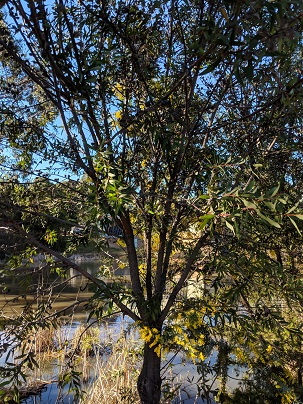
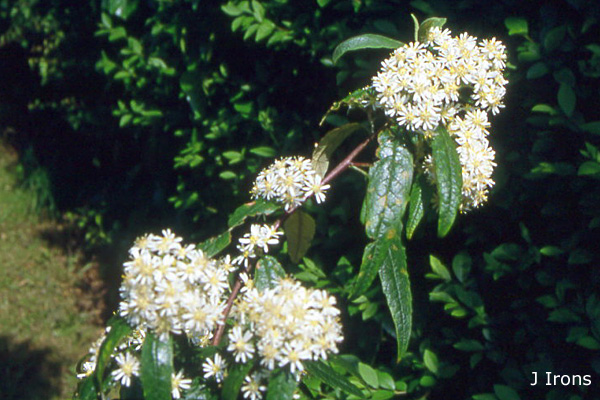
Figure 1: A Tree Hakea sampled during the project and the Stary Daisy Bush sampled for the project
Stary Daisy Bush (Olearia stellulata – BMP2022001)
This sample was also collected at the Mt Helen Campus in 2022 and at this point shows no sign of toxicity! It does however show an ability to inhibit the growth of a gram-positive bacteria and a few gram-negative bacteria including Klebsiella pneumoniae, which naturally occurs in your intestine, but can cause complications if it enters the bloodstream or your lungs.
Both examples are exciting, but we absolutely need to confirm across the coming year! Thanks again for being along for the ride in semester 1 2023!
Cheers,
Ben
November 2022
Hi All,
Thanks once again to all those who participated in the Bush Medicine Project in 2022. This year in semester 2 we focussed on a new set of flora and explored their antimicrobial properties. I also have some results from semester 1 the toxicity analysis to showcase as well.
To summarise what has been done this year, I produced the following figure. It highlights the tests that were conducted this year and shows how it builds on the data we already had (faded in the background). You can click the image to see a higher-resolution version.

Figure 1: Antimicrobial Screening of plant extracts.
There are quite a few interesting “hits” where antimicrobial activity was observed, one such stand out is the common heath (Epacris impressa) as it showed broad activity against a range of both gram-positive and gram-negative bacteria.
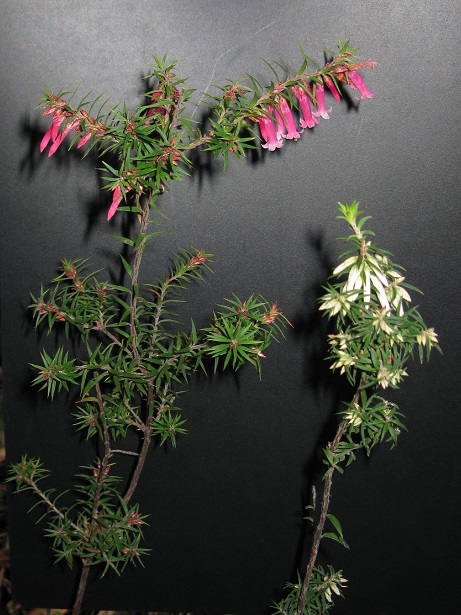
Figure 2: Image of the common heath.
In semester 1 we also tested for toxicity, while unfortunately, no students uploaded their data to the Bush Medicine Databases, Mark Myers and I were able to extract the data from some practical reports!
We have data from a single plant species – Cherry Ballart (Exocarpos cupressiformis). One sample showed no toxicity and one sample which showed higher toxicity than Panadol. So, one that needs some following up! Next year we will look to have a better pipeline for toxicity testing.
Thanks for tuning in and participating this year. For those of us finishing with FedUni, you can stay in touch with the project via our website which will be updated with this data shortly!
Cheers,
Ben
November 2021
Hi All,
As with all things 2021, it was a challenge to run the Bush Medicine project, and I wanted to extend a special thanks to everyone who participated in the project this year student and staff alike.
Working around lockdowns we were able to run a few voluntary field trips for the Australian Flora students who collected samples. During lockdowns, we had the approval to run Medicinal Chemistry labs and as things were easing up some Clinical Microbiology students were able to squeeze some additional testing into their busy condensed schedule. Nothing ran as planned, but it ran, nonetheless.
All the data is now uploaded into the databases and I have transformed some of this into more user-friendly figures. There is a map displaying where the plants were collected as well.
[Click Here To View All The Results]
As a summary of the data, this year we were able to collect 18 plant samples of which 16 were made into extracts. Of these extracts, 8 were tested against a range of microorganisms. This range included 4 newly tested plants and 3 new microorganisms. As you can see in figure 1 below, we were not able to test all combinations of plants (i.e. barcodes) with all microorganisms, but we were able to note 2 plant species with potential antimicrobial activity.
 Figure 1: Activity chart of extracts vs microorganism species where green squares indicate an extract is active against a particular microorganism, grey is not active and white is yet to be tested.
Figure 1: Activity chart of extracts vs microorganism species where green squares indicate an extract is active against a particular microorganism, grey is not active and white is yet to be tested.
These two plants were the Broad-leaved peppermint (BMP2021003) and the Tree Hakea (BMP2021009 – See figure 3). Both of these plants were collected at the Mt Helen Campus. Unfortunately, none of the plants collected at the Gippsland campus were tested, however, we may test these over the summer break to get some results.
The next step is these extracts will be tested by our pharmacology and toxicology students in first semester next year, before we start another round of analysis for 2022 in semester 2.
Keep in touch and reach out!
Cheers,
Ben and the Bush Medicine Team
 Figure 2: Tree Hakea image from 2018 (BMP20180010)
Figure 2: Tree Hakea image from 2018 (BMP20180010)
November 2019
Hi all,
I recently gave a short presentation to update on the Bush Medicine Project so far. Thanks to those who came along to the Bush Medicine talk at the School of Health and Life Science Undergraduate mini-conference.
I've recorded the presentation (Skip to 3:16 to get right to the results).
Some exciting results this year (All now uploaded to our FIG SHARE site). One interesting figure from the talk above relates the activity of extracts from particular plant species to microorganisms. Highlighting that a few plants, like Hop Goodinia and Cherry Ballart, have some broad activity against Gram-positive bacteria!
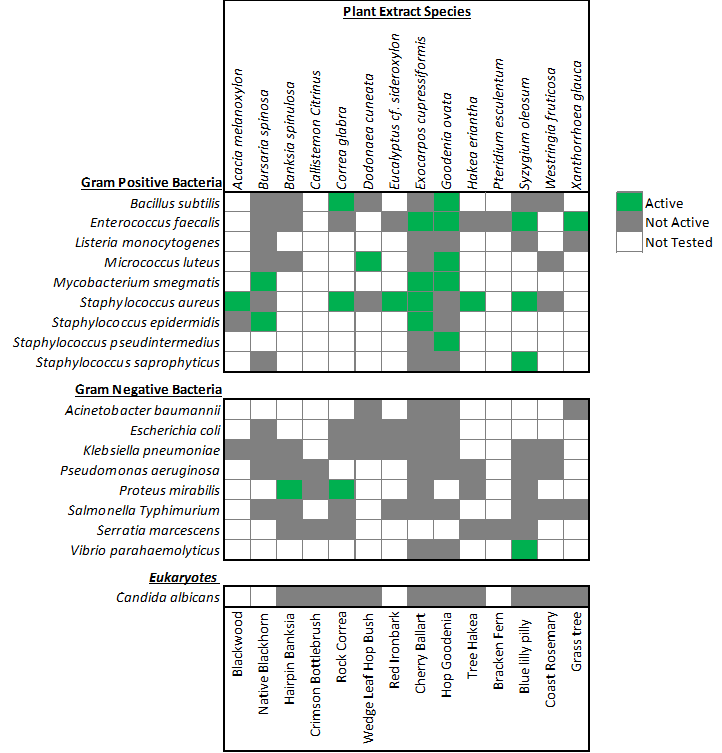
Looking forward to doing some more detailed studies with research students in the next year or two as well as continuing the project in 2020.
Cheers,
Ben
November 2018
Hi all and thanks to all those who participated in the Bush Medicine Project this last semester. In the space of a single semester our project has gone from an idea to a fully functional research project. Participation this semester from Australian Flora, Medicinal Chemistry and Clinical Microbiology has allowed for us to collect and map 36 plant samples from across Victoria, create and fingerprint 19 plant extracts and then screen 8 of those extracts against 10 microorganisms for antimicrobial activity.
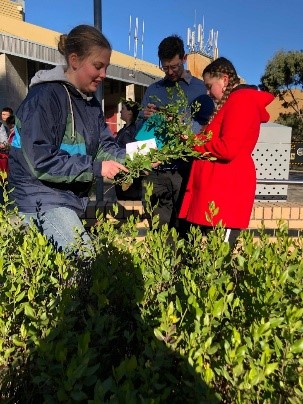 | 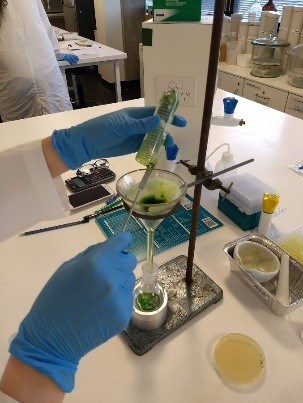 | 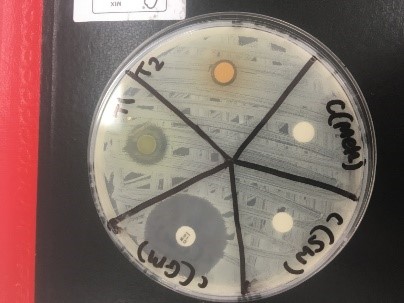 |
|---|
This is an excellent achievement for all those involved. In the below chart green boxes indicate combinations of bacteria and extract where some antimicrobial activity was noted, grey boxes indicate the extracts were tested against the bacteria but no activity was noted and white boxes were combinations that were not tested.

You can see there are a number of gaps - but there are also a few green boxes! The green highlighted boxes indicate that a few extracts showed some activity against gram positive bacteria. So what were the plants?
- 20180006 and 20180013 are both Wedge-Leaf Hop Bush (Dodinaea cuneata) which traditionally was used for colds, sore throats and fevers. (van Welzen, 2001)
- 2018011 was Hop Goodenia (Goodenia ovata) which was traditionally used as a sedative. (Vandebroek, 2001)
- 20180022 was Rock Correa (Correa cf glabra) which is in the same family as the citrus fruits (Rutaceae Family).
- 20180025 was Red Iron Bark (Eucalyptus cf sideroxylon). Which isn’t really surprising that it displays any antimicrobial activity as it is a eucalypt and eucalyptus oil is used in a modern context for that purpose. Although, it will be interesting to see if the aqueous extracts are less toxic to mammalian cells than the oil!
So… Where to from here? Over the summer, we have some students interested in confirming and quantifying the results of the “Hits” that we have found together this semester. To get a better idea of the antimicrobial properties of the above plants. Next semester, we will involve the pharmacology and toxicology students and test all the above extracts with mammalian cells to test for toxicity. Finally in semester 2 next year we will look towards filling the gaps in the chart above and expand our reach to some untested species. 2019 will be an exciting time for the project.
For a number of you this will be your last semester at Federation University, if you want to keep up to date with the project you can do so by visiting our new web page on the university website (https://federation.edu.au/bush-medicine-project). It’s currently a placeholder but in the next few weeks will be updated with a news section and a few extra features for viewing our data. You can keep up to date through there.
Thanks again all!
Stay tuned for future updates,
Ben Long